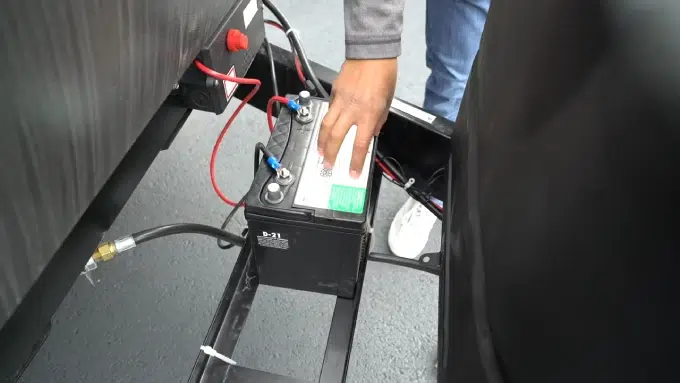Last Updated on May 4, 2023
If you’re planning a road trip in an RV, keeping your battery charged should be your top priority. It keeps your vehicle running and provides power to all the creature comforts you need on the road.
But what if you’re parked at a campsite and want to keep your battery charged? That’s where trickle charging comes in. You can keep your battery charged using a trickle charger while still connected to your RV.
It’s an easy process and one that can save you a lot of hassle and headaches down the road. Today we’ll dive into everything you need to know about trickle charging your RV battery while connected and how to do it correctly. So buckle up and let’s get started.
How Can You Trickle Charge RV Battery While it is Connected?
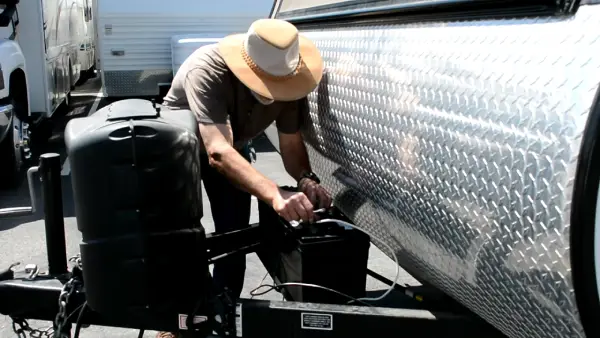
Trickle charging is a process of charging a battery slowly over an extended period. It is also known as float charging because the battery is charged at a rate that matches its self-discharge rate, which keeps it fully charged without overcharging.
Trickle charging works for RV batteries by continuously providing a small amount of current to the battery, which helps maintain its charge level. This method is beneficial for RV batteries not used for an extended period, as it prevents sulfation and extends the battery’s life.
The trickle charger typically has a low amperage output and can be left connected to the RV battery indefinitely without causing any damage. The charger will automatically adjust its output based on the voltage level of the battery, ensuring that it does not overcharge or undercharge.
Benefits of Trickle Charging your RV Battery
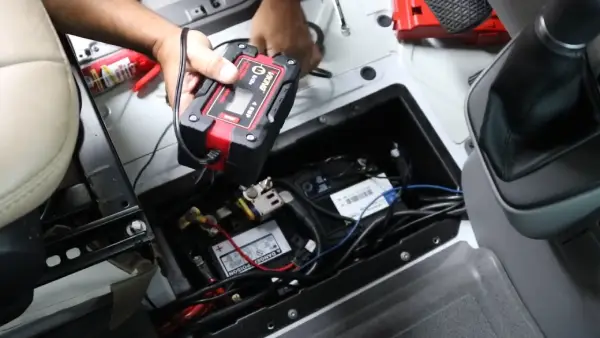
Trickle charging your RV battery has many benefits that can extend the life of your battery and save you money in the long run.
Maintain Consistent Charge Level
One of the main benefits of trickle charging is that it helps maintain a consistent charge level in your RV battery. This means you won’t have to worry about your battery losing power when you need it most, such as during a camping trip or while driving your RV.
Prevent Sulfation
Another benefit of trickle charging is that it can help to prevent sulfation, which occurs when lead-acid batteries are left discharged for extended periods. Sulfation can cause permanent damage to your battery and reduce its overall lifespan.
Avoid Overcharging
Trickle charging also allows you to avoid overcharging your RV battery, which can be harmful and shorten its lifespan. By providing a slow and steady charge, trickle charging ensures your battery receives the power it needs to stay healthy.
Types of trickle chargers available for RV batteries:
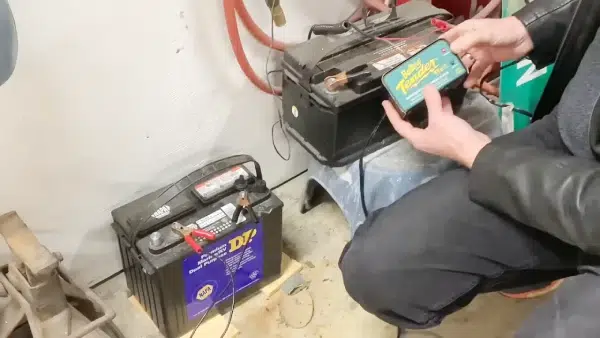
Different types of trickle chargers are available, each with unique features and benefits.
#1 Float Charger
One type of trickle charger is the float charger. This type of charger is designed to maintain a fully charged battery without overcharging it. It delivers a constant low-level charge to the battery, keeping it at full capacity.
These chargers are ideal for long-term storage or when you don’t plan on using your RV for an extended period.
#2 Automatic Smart Charger
Another type of trickle charger is the automatic smart charger. This type of charger uses advanced technology to monitor the battery’s voltage and adjust the charging rate accordingly.
It can also detect when the battery is fully charged and automatically switch to a maintenance mode, which delivers a small charge to keep the battery at full capacity.
#3 Manual Charger
The third type of trickle charger is the manual charger. This charger type requires you to manually monitor and disconnect the charging process once the battery is fully charged. Manual chargers are less expensive than other types but require more attention and care.
How to Select a Trickle Charger for an RV Battery
When selecting a trickle charger for your RV battery, several factors must be considered.
- First, consider the voltage and amperage requirements of your RV battery. Ensure you choose a charger that matches these requirements to avoid damaging your battery.
- Next, consider the charging speed of the charger. If you need your RV battery charged quickly, choose a high-speed charger with a high amperage rating. But to maintain your battery’s health over time, choose a slower charging option like a float or smart charger.
- Finally, consider any additional features that may be useful for your needs, such as safety features like short circuit protection or LED indicators that show when the battery is fully charged.
How to Prepare Your RV Battery for Trickle Charging?
To ensure that your RV battery is ready for trickle charging, there are a few steps you need to take. These steps will help to ensure that the charging process goes smoothly and that your battery is charged effectively.
The first step in preparing your RV battery for trickle charging is to inspect the battery. Check for any signs of damage or wear and tear, such as cracks or leaks. If you notice any issues with the battery, it may be best to replace it before attempting to charge it.
Next, clean the battery terminals. Over time, dirt and corrosion can build up on the terminals, interfering with the charging process. Use a wire brush or sandpaper to remove any buildup from the terminals gently.
It’s also important to check the water levels in your battery before trickle charging. Most RV batteries are lead-acid batteries and require water to function properly. If the water levels are low, mix them with distilled water before connecting the charger.
How to Connect the Trickle Charger to The RV Battery
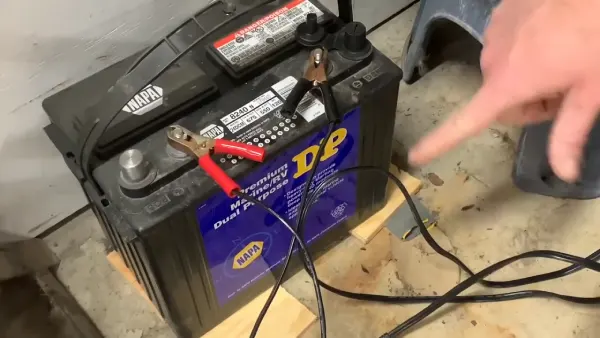
When connecting a trickle charger to your RV battery, safety should always be your top priority. Before you begin, ensure that the charger is compatible with your battery and that you have read the manufacturer’s instructions carefully.
To connect the charger, follow these simple steps:
- Locate the battery on your RV and identify the positive (+) and negative (-) terminals. These are usually marked with red and black colors, respectively.
- Turn off all electrical devices in your RV and unplug any shore power connections.
- Connect the charger’s positive clamp to the battery’s positive terminal. Ensure that it is securely attached.
- Connect the charger’s negative clamp to the battery’s negative terminal. Again, ensure that it is securely attached.
- Once both clamps are connected properly, turn on the charger and set it to trickle charge mode.
- Monitor your battery while it charges, ensuring it does not overcharge or overheat.
- When you’re ready to disconnect the charger, turn off its power switch before removing its clamps from your RV’s battery terminals in reverse order (negative than positive).
Can You Trickle Charge an RV Battery While It Is Connected?
While trickle charging an RV battery, it is safe to leave it connected if you take certain precautions. For example, ensure all electrical systems are turned off to avoid any power surges or fluctuations that could damage the charger or the battery.
Monitoring the battery and charger’s temperature during trickle charging is also essential. If either becomes too hot, disconnect them immediately and allow them to cool down before resuming charging.
How Long Should You Trickle Charge Your RV Battery?
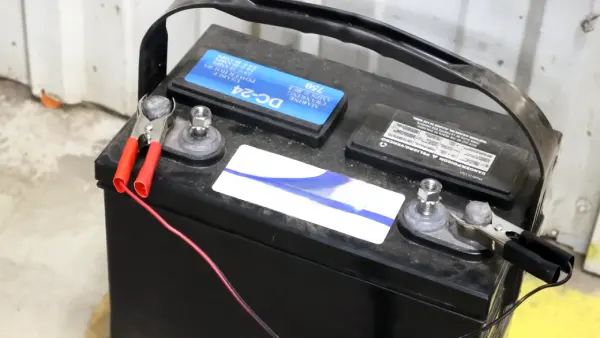
The answer to this question depends on the type of battery you have and the charger you are using. Generally, it is safe to trickle charge a lead-acid battery for an extended period if the charger has an automatic shut-off feature that prevents overcharging.
This feature will turn off the charger once the battery reaches full capacity, preventing any damage from occurring. But, if you have a lithium-ion battery, it is important to be cautious when trickle charging.
These batteries can be damaged by overcharging or undercharging, so it’s essential to use a charger specifically designed for lithium-ion batteries and follow the manufacturer’s instructions carefully.
Precautions when Trickle Charging Your RV Battery
Trickle charging your RV battery can be a great way to maintain its charge and extend its lifespan. But you must take some precautions when doing so:
- Ensure that your charger is designed for trickle charging. Using a regular charger can overcharge the battery and cause damage. Look for chargers with a “trickle” or “maintain” mode, which will keep the battery at a steady charge without overloading it.
- Be sure that the charger is connected properly. Ensure that the positive and negative terminals on the charger match those on the battery. You risk damaging the charger and the battery if they don’t match.
- Keep an eye on the temperature of the battery while trickle charging. If it becomes too hot, disconnect the charger immediately, as this could indicate an issue with either the battery or the charger.
- Never leave your RV unattended while trickle charging your battery. While rare, there have been cases of batteries overheating and causing fires. It’s always better to err on the side of caution and stay nearby while your battery charges.
Common Mistakes to Avoid When Monitoring
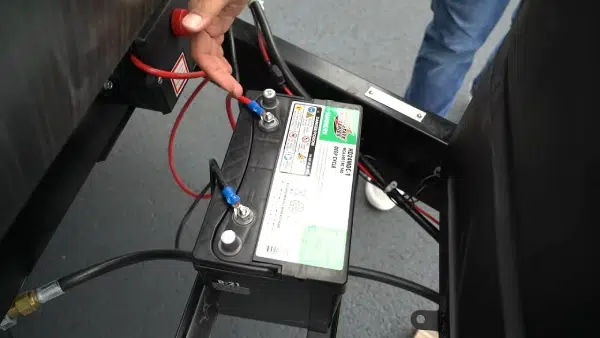
When trickle charging your RV battery, it is important to monitor the process closely to avoid common mistakes that can lead to damage or even failure.
Here are some common mistakes you should avoid:
- Overcharging: Trickle charging is a slow and steady process that should not overcharge your battery. But if you leave the charger connected for too long, it can cause damage to the battery by overheating and boiling off electrolyte fluid. Set a timer or use a charger with an automatic shut-off feature to avoid this mistake.
- Undercharging: If you disconnect the charger too early, your battery may not be fully charged and will not perform optimally. It is crucial to monitor the voltage level of your battery regularly and ensure that it reaches its full capacity before disconnecting the charger.
- Ignoring warning signs: Your RV battery may give off warning signs while trickle-charged, such as excessive heat or unusual noises. Ignoring these signs can lead to serious damage or even battery explosion. Always pay attention to any unusual behavior from your battery and take appropriate action immediately.
- Using incompatible chargers: Not all chargers are compatible with all types of batteries. Using an incompatible charger can result in undercharging or overcharging, damaging your battery permanently. It is important to choose a charger that is specifically designed for your RV battery type.
Enjoy Hassle-Free RVing with Trickle Charging Benefits
Trickle charging your RV battery is an excellent way to maintain charge and extend lifespan. But you must understand the trickle charging process and the precautions to take.
Remember, always disconnect any loads or devices from the battery before trickle charging it. This will prevent any damage to your RV’s electrical system. Also, ensure you use a charger specifically designed for trickle charging and follow the manufacturer’s instructions carefully.
Ultimately, consider trickle-charging regularly to keep your RV battery in good condition and avoid unexpected breakdowns. Just be sure to follow the necessary precautions and monitor the process closely.

